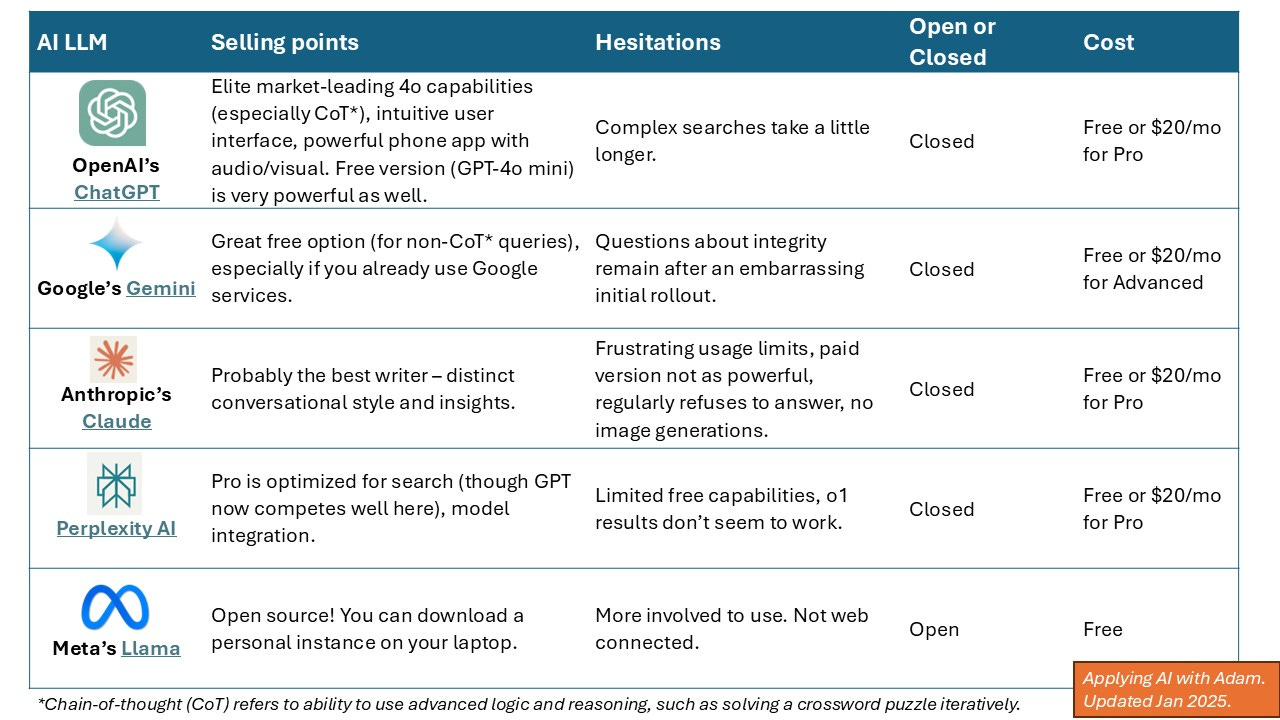This blog isn’t about AI tools—it’s about how to apply them effectively. But to get started, you’ll need at least one good AI tool in your toolkit. So, let’s take a moment to explore some available options and get acquainted with what’s out there. Whether you’re just starting your AI journey or already well on your way, I hope you’ll discover something useful here.
Note: This post was updated in January 2025, and given the rapid pace of AI technology advances, the info could change quickly. I’ll update this periodically to stay current.
Essential: Meet the Popular Large Language Models
If you’re reading this, you’re likely interested in using AI—and the first step is signing up for an AI service (if you haven’t already). Most of the exercises and content in this blog focus on working with large language models (LLMs) like ChatGPT, many of which are free to use. You just need access to one.
While LLMs share similar foundations, each has its own idiosyncrasies and areas of expertise. All of them, however, are incredibly powerful tools that will serve our purposes well.
Below, you’ll find a comparison of some of today’s most popular and capable LLMs, along with a bit of analysis (IMHO) to help you choose the right one to get started.
These are all powerful tools, but my top two recommendations are ChatGPT and Gemini for most people. Both offer free versions, so you can explore them and see which feels right for you.
If you’re willing to spend $20/month (and I think it’s well worth it), ChatGPT is a great choice. It offers impressive capabilities, a user-friendly mobile app, and an intuitive interface. For those who prefer not to pay a premium—especially if you’re already using Google services like Google Drive—Gemini is an excellent alternative.
Either one (or really any of them) will get you off to a solid start. So, if you’re ready, feel free to stop here and move along! But if you’re curious, there’s a whole world of AI tools out there to explore…
Getting Creative: Image & Video Generators
First the bad news: you should probably verify every single video and audio recording moving forward before you rely on its accuracy, at least until we have a definitive way of marking “synthetic media” versus the real thing. So yeah… there’s that.
But the good news: it is now trivially easy to generate photos, images, and voice recordings for a variety of fun, professional, (and ethical!) reasons. Want a virtual tutor for yourself or your eLearning course? Easy. Want to generate a customer service avatar for your company website? Yours for $15/mo. Want to create an AI clone of yourself in five minutes for fun? Go for it.
Out of the box, both ChatGPT and Gemini integrate generated images into their conversation results. Start there. But if you’ve got a creative side and are looking for something a little more powerful, here are a few of the fantastic image and video generators on the market to explore.
Links: ChatGPT, Gemini, Midjourney, Firefly, D-iD, ElevenLabs
This technology has advanced remarkably over the past two years, with new text-to-video services recently making their debut (perhaps more on those in a future post). While these tools are fun to experiment with, they won’t be a primary focus here.
What I do want to highlight is how rapidly AI-generated content—across audio, text, images, and video—has evolved, making it easier than ever to create highly realistic ‘synthetic media’ that rivals real life. (It’s incredible to see how far we’ve come since I created my first generated video back in 2007!)
AI Tools. So many tools…
There are already many AI tools built on foundational LLMs, with more being released every day. Some are professionally designed by major tech companies, like Microsoft’s Copilot (powered by OpenAI’s ChatGPT) and Google’s NotebookLM (powered by Gemini 1.5 Pro). These tools are polished and highly capable, with many geared towards professional use.
Beyond the big names, thousands of AI tools are being created by smaller, independent teams using LLM APIs in unique and innovative ways. If you’re curious, check out AI tool aggregators like Future Tools or Easy with AI. These platforms showcase a wide range of tools, and you’re likely to find a few that resonate with you. Just keep in mind that when there’s almost literally an AI for that, you’ll also find duds.
Keeping up with AI news
There is no shortage of media outlets, blogs, YouTube channels, and more to keep you current on the latest news and AI developments. The amount of buzz can be overwhelming. If you only have time (or interest) to follow one source – well, two, if we count Applying AI of course! – I highly recommend Ethan Mollick’s excellent Substack One Useful Thing. It’s a fascinating and timely resource that explores how AIs are evolving and the implications of it all.
Alright, I’m going to stop there. With that you have the tools - really the single LLM tool – that you need to dive in and get started.






